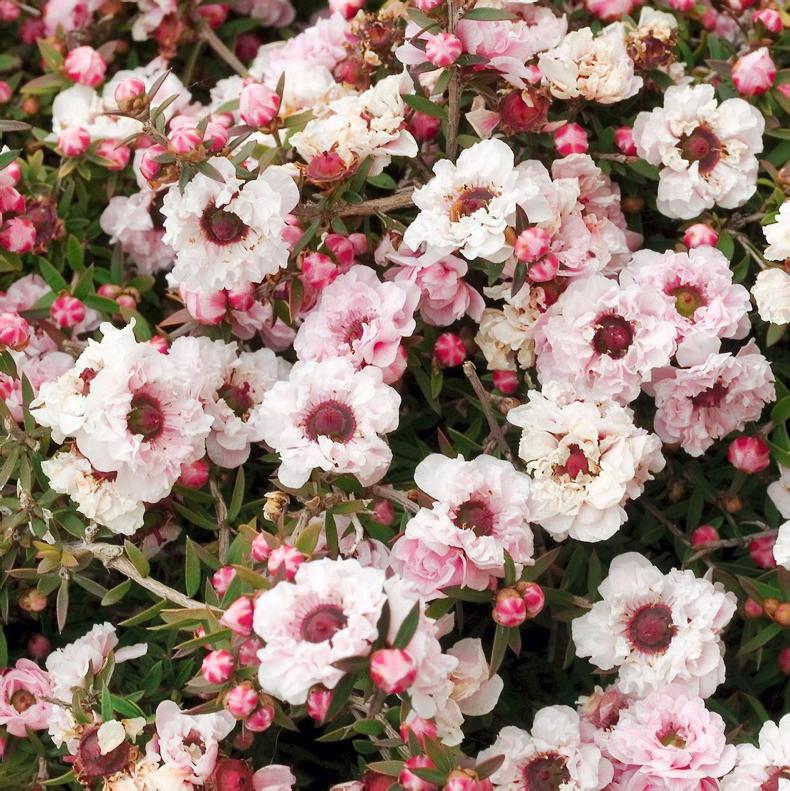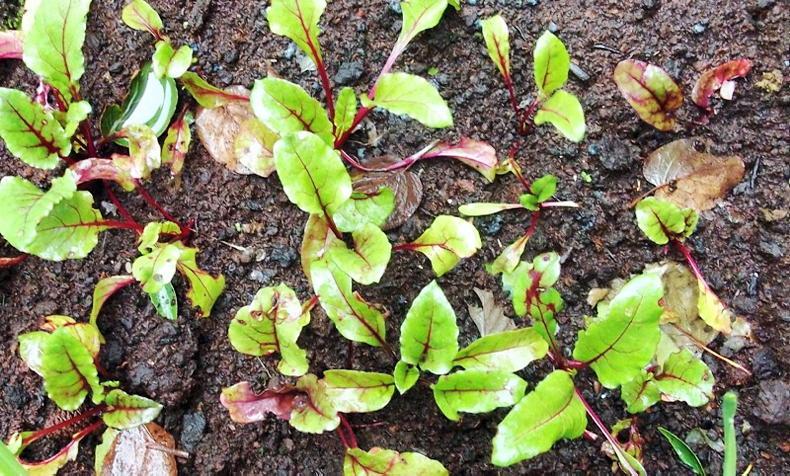Name: New Zealand ‘tea tree’ is a fine, and catchy, common name but that name is very little used in this country. Native to New Zealand and Australia, it is known as tea tree in those countries, or by the name ‘manuka’ which is its Maori name.
It got the name ‘tea tree’, according to tradition, because the early settlers tried it as a beverage. Although the New Zealand tea tree is used in aromatherapy, this is not the same plant that produces the tea tree oil used in cosmetics, which is derived from melaleuca, related to leptospermum.
Botanical name: Both are members of the myrtle family, which notably includes eucalyptus, famous for its use as a medicinal plant. The most common kind is Leptospermum scoparium, which also has many forms and varieties. The second part of the name means ‘broom-like’, which it is.
One of the nicest is ‘Red Damask’ which has dark-red double flowers on a large bush. ‘Pink Cascade’ is a beauty with pink flowers in a cascading habit. ‘Kiwi’ is a small bush, not more than about one metre tall, with dark pink single flowers. ‘Snow Flurry’ has double white flowers and they are produced in masses. ‘Nicholsii’ has crimson flowers and bronze leaves.
Garden value
The flowers are small, cup-shaped, like tiny roses, and there are double-flowered forms. These are uncannily like full-flowered double roses in miniature, about one 10th the diameter, and they are not related to roses at all.
The flowers are carried in great profusion along the small twigs, so much so that the whole plant can appear red pink or white from a distance.
The leaves are very tiny and pointed and the twigs are slender. It is evergreen and takes on a grey-green colour when not in flower, and makes a good backdrop of foliage. It looks a bit like an overgrown heather bush but is several times taller.
Some kinds are more grey than others, because of the covering of fine hairs on the leaves, those with more hairs appearing more grey. Grown as a tree, it has nice flaky bark that develops with age. As a tree, it very often leans over, but this is not a serious flaw – in fact, a leaning specimen can be quite attractive.
Growing tea tree
The tea tree is hardy in mild areas but can be hit hard by frost in colder inland areas. Old plants have thicker, more protective bark and survive better than young plants which tend to be very vigorous and somewhat soft. Make sure to plant it in a sunny position in well-drained, even gravelly soil. The soil should not be too rich or the bush will grow very rapidly and may not remain all that secure.

Leptospermun scoparium apple blossom New Zealand tea tree.
If the roots are wrapped around the pot when the pot is taken off, they should be untangled or cut through to ensure the plant makes good anchor roots. It is common for leptospermum which had the roots wrapped around the pot at planting to blow over after a few years when its large top catches the wind. Although it is tolerant of fairly stiff exposure to wind, in an exposed garden, a short stake might be a wise precaution.
As vegetables sown in recent weeks make growth, thinning is essential. Very often this is left too late and the plants are weakened and set back when their neighbours are yanked out. The roots of well-established neighbouring seedlings are almost always bound together and damage can result when one is removed.
It is not uncommon to see plants get a check that takes a week or more to recover from. In theory, therefore, the earlier the thinning can be done, the better.
If it can be done at the two-leaf stage, so much the better, but there is a risk in that too, because carefully spaced seedlings are at risk of severe losses due to snails. One big snail could easily ruin a row of tiny seedlings in a single night.

Thinning beetroot
Wise precaution
Two-stage thinning therefore is a wise precaution. Very early thinning can be carried out leaving the seedlings at quarter or half of the final spacing. If there are losses, there are replacements available.
Another advantage is that the half-grown seedlings can often be used as very tender baby vegetables, such as lettuce, Swiss chard and beetroot, the leaves and stems making fine stir-fry vegetables.
Fruit, vegetables and herbs
Deal with weeds as soon as possible, though it has been difficult to get the soil dry enough to hoe weed
seedlings. Sow carrots, broccoli,
lettuce and peas, and thin out vegetables that have reached suitable size. Sow savoy cabbage and other winter varieties.
Lawns
Grass has responded well to increasing temperatures, after a cold and sometimes very wet spring. If you grow your lawn as wildflower lawn, it needs to be cut regularly. Take note that a wildflower meadow is not the same thing as it is only mown after flowering.
Trees, shrubs and roses
Continue to tie in the new shoots of climbing roses so that they will be in the correct position for training later. Young trees and shrubs planted in
the last 12 months can be suffering
from moisture shortage due to the inability of the roots to take up adequate water.
Flowers
There is still plenty of time for late seed-sown plants to flower well, especially when grown as large plants. Perennial flowers have a tendency to fall over and some staking might be needed.
Greenhouse and house plants
Use a greenhouse shading material now if the house is inclined to get too hot. Continue to feed greenhouse plants every two weeks to get good growth before midsummer and
continue to water well. Spray a grapevine if it shows mildew in the early stages.
Name: New Zealand ‘tea tree’ is a fine, and catchy, common name but that name is very little used in this country. Native to New Zealand and Australia, it is known as tea tree in those countries, or by the name ‘manuka’ which is its Maori name.
It got the name ‘tea tree’, according to tradition, because the early settlers tried it as a beverage. Although the New Zealand tea tree is used in aromatherapy, this is not the same plant that produces the tea tree oil used in cosmetics, which is derived from melaleuca, related to leptospermum.
Botanical name: Both are members of the myrtle family, which notably includes eucalyptus, famous for its use as a medicinal plant. The most common kind is Leptospermum scoparium, which also has many forms and varieties. The second part of the name means ‘broom-like’, which it is.
One of the nicest is ‘Red Damask’ which has dark-red double flowers on a large bush. ‘Pink Cascade’ is a beauty with pink flowers in a cascading habit. ‘Kiwi’ is a small bush, not more than about one metre tall, with dark pink single flowers. ‘Snow Flurry’ has double white flowers and they are produced in masses. ‘Nicholsii’ has crimson flowers and bronze leaves.
Garden value
The flowers are small, cup-shaped, like tiny roses, and there are double-flowered forms. These are uncannily like full-flowered double roses in miniature, about one 10th the diameter, and they are not related to roses at all.
The flowers are carried in great profusion along the small twigs, so much so that the whole plant can appear red pink or white from a distance.
The leaves are very tiny and pointed and the twigs are slender. It is evergreen and takes on a grey-green colour when not in flower, and makes a good backdrop of foliage. It looks a bit like an overgrown heather bush but is several times taller.
Some kinds are more grey than others, because of the covering of fine hairs on the leaves, those with more hairs appearing more grey. Grown as a tree, it has nice flaky bark that develops with age. As a tree, it very often leans over, but this is not a serious flaw – in fact, a leaning specimen can be quite attractive.
Growing tea tree
The tea tree is hardy in mild areas but can be hit hard by frost in colder inland areas. Old plants have thicker, more protective bark and survive better than young plants which tend to be very vigorous and somewhat soft. Make sure to plant it in a sunny position in well-drained, even gravelly soil. The soil should not be too rich or the bush will grow very rapidly and may not remain all that secure.

Leptospermun scoparium apple blossom New Zealand tea tree.
If the roots are wrapped around the pot when the pot is taken off, they should be untangled or cut through to ensure the plant makes good anchor roots. It is common for leptospermum which had the roots wrapped around the pot at planting to blow over after a few years when its large top catches the wind. Although it is tolerant of fairly stiff exposure to wind, in an exposed garden, a short stake might be a wise precaution.
As vegetables sown in recent weeks make growth, thinning is essential. Very often this is left too late and the plants are weakened and set back when their neighbours are yanked out. The roots of well-established neighbouring seedlings are almost always bound together and damage can result when one is removed.
It is not uncommon to see plants get a check that takes a week or more to recover from. In theory, therefore, the earlier the thinning can be done, the better.
If it can be done at the two-leaf stage, so much the better, but there is a risk in that too, because carefully spaced seedlings are at risk of severe losses due to snails. One big snail could easily ruin a row of tiny seedlings in a single night.

Thinning beetroot
Wise precaution
Two-stage thinning therefore is a wise precaution. Very early thinning can be carried out leaving the seedlings at quarter or half of the final spacing. If there are losses, there are replacements available.
Another advantage is that the half-grown seedlings can often be used as very tender baby vegetables, such as lettuce, Swiss chard and beetroot, the leaves and stems making fine stir-fry vegetables.
Fruit, vegetables and herbs
Deal with weeds as soon as possible, though it has been difficult to get the soil dry enough to hoe weed
seedlings. Sow carrots, broccoli,
lettuce and peas, and thin out vegetables that have reached suitable size. Sow savoy cabbage and other winter varieties.
Lawns
Grass has responded well to increasing temperatures, after a cold and sometimes very wet spring. If you grow your lawn as wildflower lawn, it needs to be cut regularly. Take note that a wildflower meadow is not the same thing as it is only mown after flowering.
Trees, shrubs and roses
Continue to tie in the new shoots of climbing roses so that they will be in the correct position for training later. Young trees and shrubs planted in
the last 12 months can be suffering
from moisture shortage due to the inability of the roots to take up adequate water.
Flowers
There is still plenty of time for late seed-sown plants to flower well, especially when grown as large plants. Perennial flowers have a tendency to fall over and some staking might be needed.
Greenhouse and house plants
Use a greenhouse shading material now if the house is inclined to get too hot. Continue to feed greenhouse plants every two weeks to get good growth before midsummer and
continue to water well. Spray a grapevine if it shows mildew in the early stages.








 This is a subscriber-only article
This is a subscriber-only article










SHARING OPTIONS: